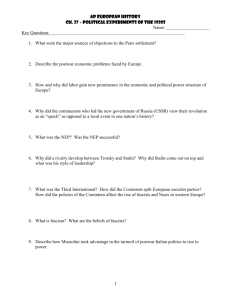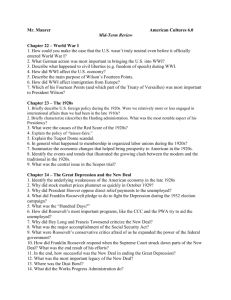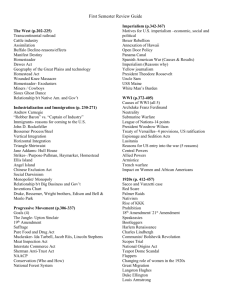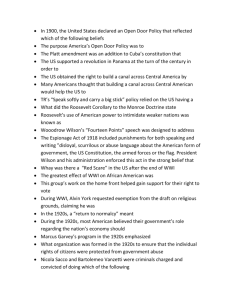Chapter 27: Political Experiments of the 1920s POST
advertisement
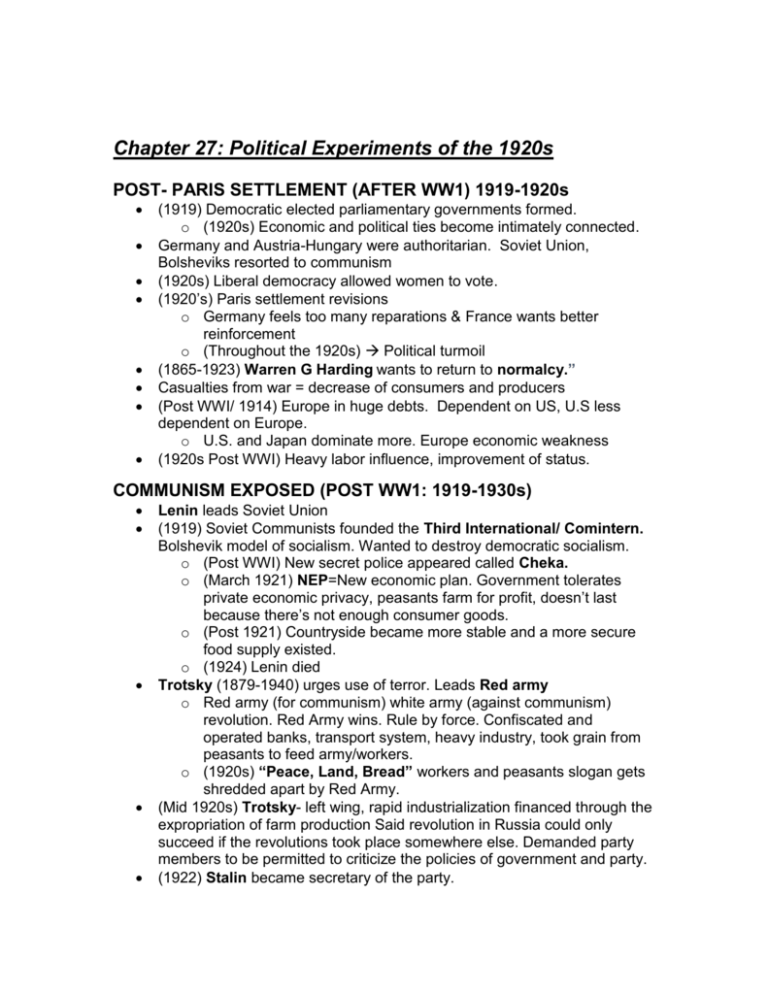
Chapter 27: Political Experiments of the 1920s POST- PARIS SETTLEMENT (AFTER WW1) 1919-1920s (1919) Democratic elected parliamentary governments formed. o (1920s) Economic and political ties become intimately connected. Germany and Austria-Hungary were authoritarian. Soviet Union, Bolsheviks resorted to communism (1920s) Liberal democracy allowed women to vote. (1920’s) Paris settlement revisions o Germany feels too many reparations & France wants better reinforcement o (Throughout the 1920s) Political turmoil (1865-1923) Warren G Harding wants to return to normalcy.” Casualties from war = decrease of consumers and producers (Post WWI/ 1914) Europe in huge debts. Dependent on US, U.S less dependent on Europe. o U.S. and Japan dominate more. Europe economic weakness (1920s Post WWI) Heavy labor influence, improvement of status. COMMUNISM EXPOSED (POST WW1: 1919-1930s) Lenin leads Soviet Union (1919) Soviet Communists founded the Third International/ Comintern. Bolshevik model of socialism. Wanted to destroy democratic socialism. o (Post WWI) New secret police appeared called Cheka. o (March 1921) NEP=New economic plan. Government tolerates private economic privacy, peasants farm for profit, doesn’t last because there’s not enough consumer goods. o (Post 1921) Countryside became more stable and a more secure food supply existed. o (1924) Lenin died Trotsky (1879-1940) urges use of terror. Leads Red army o Red army (for communism) white army (against communism) revolution. Red Army wins. Rule by force. Confiscated and operated banks, transport system, heavy industry, took grain from peasants to feed army/workers. o (1920s) “Peace, Land, Bread” workers and peasants slogan gets shredded apart by Red Army. (Mid 1920s) Trotsky- left wing, rapid industrialization financed through the expropriation of farm production Said revolution in Russia could only succeed if the revolutions took place somewhere else. Demanded party members to be permitted to criticize the policies of government and party. (1922) Stalin became secretary of the party. Beliefs: Bureaucratic and administrative methods. Socialism achieved in Russia alone. Russia’s success didn’t depend on the fate of revolutions elsewhere. (1929) Trotsky was forced out of Russia. o (1920s-1930s) Separated Russia… communist vs. social democratic parties. Communists and social democrats fought each other. FASCISTS IN ITALY: (Post WWI: 1919-1929) (Post WWI definition) Fascism= Anti-democratic, anti-Marxist, antiparliamentary, anti-Semitic. Normal parliamentary politics and parties sacrificed national honor and greatness to petty disputes. (1883-1945) Benito Mussolini leader of right wing dictatorship. (1919- Fasci organization was just another political group in Italy. (1919) Fasci di Combattimento or “Bands of Combat” was formed. Political survival. Action more important than thought or rational justification. Rule by terror and fear. (1919-1921)- internal social turmoil. Industrial strikes. (October 1922) March on Rome- Fascists marched to Rome. King of Rome Victor Emmanuel III refused to sign a decree to send an army to stop the march. This allowed fascists to come to power. (October 29, 1922) Mussolini asked to become prime minister. Achieves authority. o (1922) Fascists appointed to office. Gained control of Chamber of Deputies. Dominance at every level. Obtained power legally. o (November 23, 1922) Granted Mussolini dictatorial authority for one year to bring order to local and regional government. o (Late 1924) Mussolini changed election law to party that gained largest popular vote won 2/3 of the seats in Chamber. o (1925-1926) Passed laws permitting Mussolini to rule by decree. o (1926) All other political parties were dissolved. Mussolini transformed Italy into a single-party dictatorial state. (1929) Lateran Accord- Mussolini confirmed pope’s power to grant titles. o Recognized sovereignty of the Holy See in the Vatican City. o Financial convention agreed on as a definitive settlement of the claims of the Holy See following the losses of its territories and property. o Brought further respectability to Mussolini’s authoritarian regime. FRANCE (1920-1930) (1920) “Blue Horizon Chamber,” defeated Georges Clemenceau’s bid for presidency. Conservative. Accepted leading role of Europe. (1920s) Frequent ministry changes and drift in domestic policy. (Post WW1) Wants Germany extremely weak. (1920-1921) Formed the Little Entente- Czechoslovakia, Romania, Yugoslavia. o Had much to lose from the Versailles treaty. France made military alliance with this. o Weaker than Franco-Russian alliance. (January 11, 1923) Poincare, prime minister of France takes French troops to Germans Ruhr mining area. French civilians run German mines and railroads. Prevailed. Germany pays, but France’s victory was costly. German inflation increased and hurt the French economy. (1924) Poincare’s conservative ministry gave way to a coalition of leftist parties, the Cartel des Gauches. Aristide Briand (1862-1932)- foreign minister for the remainder of the 1920s. o Recognized the Soviet Union and adopted a more conciliatory policy toward Germany. o Foreign minister. o Championed League of Nations o Mild inflation. Prosperity until 1931 longer than any other nation. BRITAIN (1918-1926) (1918) Parliament expanded the electorate to include all men aged 21 and women nagged 30. Lloyd George- Prime minister conservative mercy. (1918) Against the wishes of the liberals and Labor Party, he maintained the coalition through tasks of the peace conference and the domestic reconstruction. (1922) Accepts dole. (1866-1937) Ramsay MacDonald- Forms first Labor ministry in British History o Wants extensive social reform. Proved the Labor party was loyal and respectable and responsible. o (1923) Labor Party- Socialist, non-revolutionary, democratic. (1925) Returned to the Gold Standard- Conservative set the conversion rate for the pound too high against other currencies, raised price of British goods to foreign customers. (1926) General Strike - Britain was trying to get their economy out of rut o They tried cutting wages = directly affected the coal miners. Coal miners went on strike. o Lasted 9 days. Little violence. o Organized labor in a weak position Stanley Baldwin- Prime minister, conservative. Concerned to present British institutions in a favorable light. Hoped communists doctrines wouldn’t influence the British labor movement. Mohandis Gandhi (1869-1948) - Led the congress party in India. Attracted widespread support. Led British to talk more about selfgovernment in India. (1920s) British textile producers no longer had totally free access to the vast Indian market IRISH (1914-1949) (1914) Home Rule Bill --first act British parliament passed that devolved government in United Kingdom. Postponed for 12 months. o (April 1916) Easter Uprising = nationalist uprising in Dublin. Only rebellion of a national group to occur against any government engaged in war. o British executed the Irish nationalist leaders who were responsible for this caused rebels to become national martyrs. o (1918) Leadership of the nationalists shifted from Irish party in Parliament to the extreme Sinn Fein, the new extremist party in Ireland. Won all but 4 seats in Irish parliament. Made Irish Parliament. o (1919) Declared Irish independence. o (January 1921) Military wing of Sinn Fein became Irish republican army. (IRA) Dail Eireann- Irish Parliament (1921) Ulster/ Northern Ireland were permitted to remain part of the United Kingdom of Britain and Northern Ireland with provisions of home rule. Caused civil war to break out amongst diehards and moderates. Moderates wanted the treaty, diehards wanted completely independent. (1949) Republic of Eire, Irish Free State, declared itself the independent republic of Eire, or Ireland. Finally independent from Britain. SUCCESOR STATES IN EASTERN EUROPE: Post WWI (Post WWI) Succeeded portions of overturned Germany, AustroHungarian, and Russian empires. o Make new parliamentary governments function in a satisfactory and stable manner. None possessed strong economic relationships, poor. o Rural nations in industrialized world Ethnic groups able to pursue nationalistic goals w/o major interference from authority /central political authority. Still minorities within these ethnic groups that wanted to be independent or be apart of a different nation of region.= problem (1919) Poland No nationalism. No tools for industrialization. No cooperation o (1926) Pilsudski-formed military coup. Ruled after. o Had different administrative systems/ laws/ economies/degrees of experience (Post WWI) Czechoslovakia: strong industrial base. Substantial middle class. o Well educated. o Thomas Masaryk-. First president of Czechoslovakia republic. Only successful democratic state in Europe during the war. (1920s) Hungary: resentment in Hungary over lost territory in Paris Settlement. o Economy suffered o Anti-Semitic policies/ rigged elections (1920s) Austria: leftist social democrats and conservative Christian Socialists fought for power. o (1892-1934) Englebert Dollfuss- Chancellor of Austria. Tried to steer a course between Austrian Social Democrats and the German Nazi’s. (1934) Outlawed all political parties except the Christian Socialists, agrarians, and parliamentary groups. Used troops against Social Democrats but was shot later during an unsuccessful Nazi Coup. Southeastern Europe: Dictatorships o Military dictatorships arise. o (1917-1929) Yugoslavia- Composed of Croats, Serbs, and Slovenes. Croats and Serbs clashed. o (1929) Led to a royal dictatorship under King Alexander I. Croats thought Serbs were a corrupt administration. Serbs had more control over government and had an independent state with an army earlier before the war. o Other dictatorships in Romania and Greece. WEIMER REPUBLIC: 1920s (Post WWI) Accepted the treaty of Versailles. (1920s) Proportional representation System made it easy for small parties to gain seats in the Reichstag. Guaranteed civil liberties and provided direct election by universal suffrage. (1920s) Lack of Popular Support. (1920s) Article 48- Allowed president to rule by decree in an emergency. Promoted a temporary presidential dictatorship. (1923) Huge inflation caused by invasion of the Ruhr o (1920s) Unemployment. Disaster to middle class and lower middle class o (1920s) Stores unwilling to exchange goods for the worthless currency farmers withheld produce from the market. HITLER (1889-1945) Believes -German Nationalism, racism, extreme anti-Semitism. Hated Marxism and Jews. o (1923) Wrote My Struggle in prison. (Mein Kampf) Pursue power by legal means. o Germany must expand (1920s) Nazis / 25 points: Platform/program= repudiation of the Versailles treaty. o unification of Austria and Germany, exclusion of Jews from German citizenship, agrarian reform, prohibition of laws speculation, confiscation of war profits, o state administration of the giant cartels, replacement of department stores with small retail shops. o Subordination of all economic enterprise to the welfare of the nation. (1887-1934) SA= storm troopers under Ernst Roehm. Originally a parliamentary organization that provided troops with food and uniforms and eventually paid them. (Mid 1920s) Famous for their brown shirted uniform. o (1920s) Nazi instrument for Nazi terror and intimidation before the party controlled the government. Attacked socialists and communists. o (1920s) Means of preserving military discipline and values outside the small army permitted by the Paris settlement. STRESEMANN: 1920s (1878-1929) Gustav Stresemann = responsible for the reconstruction of the republic and giving it a sense of self-confidence. o (1923) Chancellor of Germany o (1920s) Conciliatory. Aimed to recover German-speaking countries lost to Poland and Czechoslovakia and to unite with Austria by diplomatic means. o (1924) Dawes Plan- Charles Dawes (American banker). Lowered annual payments and allowed them to vary accordingly to German economy. New system of reparation payments. LOCARNO (1925) Chamberlain of Britain and Briand of France to accept Stresemann’s proposal for a fresh start. Pleased everyone: Italy recognized as great power, French happy because Germany voluntarily accepted its permanence of their western frontier, and Britain was happy to play an evenhanded role. Germany happy achieved respectability and a guarantee against another Ruhr occupation. Germany enters League of Nations. o (1928) Kellogg-Briand Pact- Major European states, Japan and US sign this renouncing war as an instrument of national policy. o (1929) Young Plan- lowered German reparations after Dawes plan ran out. Put a limit on how long they had to be made and removed Germany entirely from outside supervision and control. o (1930s) Totalitarian States- Germany and Italy were coming to emerge as being totalitarian states. Hitler and Mussolini would eventually take control, bringing about an unbalance in Europe and violating the Kellogg-Briand Pact. Chapter 28: Great Britain, France, Germany, Italy and the Soviet Union Leading up to and Dealing with the Great Depression LEADING UP TO THE GREAT DEPRESSION (Post WWI 1920’s and early 1930s) (1920s) Most European nations emerged from WWI with inflated currencies and market demand for European goods shrink. (1920s) Idle factories, fewer jobs, world wheat prices fell, lower incomes for farmers, increased price of industrial goods (1924) Dawes Plan reorganized the administration and transfer of reparations. Smoothed debt repayments to the U.S. (1925) Brief European prosperity from flow of U.S. capital. (1928) American money withdrawn from European investments into booming New York stock market. Lending contracted. (October 1929) Wall Street crashed from unregulated financial spending. Huge amounts of money lost, credit shrank severely or disappeared, and many banks failed. (May 1931) Kreditanstalt, a major bank in Vienna that was the primary lending institution for much of central and Easter Europe, collapsed. German banking was under pressure & unable to make reparations. (June 1931) Hoover Moratorium: Herbert Hoover, U.S. president, announced a one-year halt on all payments of international debts. (Summer of 1932) Lausanne Conference ended era of reparations. (Late 1920s-early 1930s) Governments not well fit to deal with depression. (1936) John Keyne’s General Theory of Employment, Interest, and Money. Theory of governments’ spending economy out of depression. GREAT BRITAIN (Post WWI: 1929-1937) (1929-1935): Labour government headed by Ramsay MacDonald. MacDonald rejected radical programs—trying to make his party respectable. MacDonald formed the National Government, a coalition ministry. (1931) National Government won by a comfortable majority. (1931): More than 2.5 million were unemployed. National government tried to attack depression: balanced budget and went off gold standard. (1932) Import Duties Bill Passed. (1932) Sir Oswald Mosley founded the British Union of Fascists. Flirted with right-wing politics. (1934) Industrial production expanded. (1937) George Orwell wrote The Road to Wigan Pier, which described the laboring districts, the poverty, and 1.5 million without jobs. (1937) Conservative Neville Chamberlain succeeded Stanley Baldwin who replaced MacDonald. FRANCE (Post WWI: early 1930s- late 1930s) (1931) Economic depression began to affect French economy. (1932) Elected another Radical coalition government. Pursued a deflationary policy & reparation payments stopped. (Early 1930s) Right-wing, authoritarian groups became active. Action Française— founded in the wake of the Dreyfus Affair and the Croix de Feu or “Cross of Fire”—composed of army veterans. (1933) Serge Stavisky, small time gangster, became involved in a fraudulent bond scheme. (1934) Stavisky Affair, the last of the Third Republic Scandals, occurred and involved a political cover up and people in high places wishing to halt the investigation. Symbolized the seaminess, immorality, and corruption of republican politics. (February 1934) Large demonstration of right wing leagues that was the largest disturbance in Paris since the Commune of 1871. (February 6, 1934) Radical ministry of Daladier replaced by a national coalition government composed of all living former premiers. (1934-1936) The French left began to make peace within its own ranks. (July 1935) The Popular Front of all left-wing parties was established to preserve the republic and press for social reform. (1936) Popular Front received a majority in the Chamber of Deputies. (1936) Socialists = largest single party in French history. Leon Blum assumed the premiership. Reorganized labor and management, raised wages, fortyhour workweek, raised salaries of civil servants and instituted a program of public works. (1936-1937) Blum devalued the Franc. (1937) Conservative banking and general business communities enraged by Blum influenced Blum to halt the reform program. (1938) Radical ministry under Daladier replaced Popular Front. (Late 1930s) Citizens question the worth of the republic. GERMANY: HITLER’S OBTAINING AND CONSOLIDATING POWER (1928-1942) (Late 1920s) The Nazi’s were a major presence in the Weimar Republic, but not real contenders for political dominance. (1928) Weimar Republic ended and a coalition of center parties and the Social Democrats governed. (1930) Coalition dissolved and left parliamentary deadlock. President von Hindenburg appointed Heinrich Brüning as Chancellor. Brüning governed through Article 48, under emergency decree. (1932) Germany unemployment rose—economic downturn and parliamentary deadlock worked to the advantage of extreme political parties. The Nazis transformed economic despair into electoral results. (1933) Hitler became the chancellor of Germany through legal means. Hitler mastered mass politics and propaganda, and relied on Josef Goebbels who was in charge of Nazi propaganda. Support for Hitler strong among farmers, war veterans, & the young. (1933) Nazis excluded the Jews from the civil service. (1933) Trade unions were crushed making strikes illegal. Required participation in the Labor Front and advocated “Strength Through Joy.” (February 1933) A mentally ill Dutch communist set fire to the Reichstag building in Berlin. Represented immediate communist threat against the government. (March 1933) Hitler ruled by degree with no legal limits of exercising power. (May 1933) The Nazi Party seized the offices, banks, and newspapers, of the free trade unions and arrested their leaders. (Late June and early July) All other German political parties were outlawed. (Late 1933) Almost 1 million unemployed joined the storm troopers, the SA. Commander of this party army was Ernst Roehm. (June 30, 1934) Hitler personally ordered the murder of key SA officers, including Roehm. Hitler was trying to protect his own position and to shore up support with the regular army. (1934) Hitler used the SS, the chief vehicle of police surveillance, to carry out the blood purges of the party. (1935) Nuremberg Laws robbed German Jews of their citizenship. (1936) Himmler became head of all police matters in Germany and was second in power only to Hitler. (1935) The specter of unemployment associated with the Great Depression no longer haunted Germany. Reversed the deflationary policy and instituted massive program of public works and spending. (1935) Renunciation of the military provisions of Versailles led to open rearmament and expansion of the German army. (November 9 and 10, 1938) Thousands of Jewish stores and synagogues were burned or destroyed in Kristallnacht. (1941-1942) Hitler destroyed the Jews in Europe More than 6 million Jews died. FASCIST ITALY (1920s-1930s) (1920s) Mussolini undertook vast public works, subsidized the shipping industry and introduced protective tariffs, and embarked on the “battle of wheat” to prevent foreign grain from appearing in Italy. The policies failed and couldn’t stop the Great Depression from affecting Italy. (1920s) Developed corporatism, which was a planned economy that linked to the private ownership of capital and to government arbitration of labor disputes. Introduced syndicates representing labor and management, which organized major industries. (Mid 1920s) Italian labor unions lost the right to strike and pursue independent goals. Management profited. (After 1930) Industrial syndicates were further organized into entities called corporations. These bodies included all industries relating to a major area of production. (1935) Italy invaded Ethiopia and economic life was put on a formal wartime footing. (1935) Government imposed a forced loan on citizens by requiring property owners to purchase bonds. (Late 1930s) Italian state assumed more and more direction over economy. (1938) Mussolini abolished Italian Chamber of Deputies and replaced it with a Chamber of Corporations. SOVIET UNION: PATH TO INDUSTRIALIZATION (1927-1940) (1927) Lenin’s New Economic Policy had championed, but industrial growth slowed. (1927) Party Congress decided to push for rapid industrialization. (1928) Sharp departure from NEP—“industrialization by political mobilization.” (1928) Stalin’s organizational vehicle for industrialization was a series of five-year plans. The State Planning Commission or Gosplan oversaw the program setting foals for production and attempting to organize the economy. (Late 1930s) The drive to rapid industrialization allowed the government to reimpose strict discipline. (1930s) Industrialization achieved fully employed labor force, but a labor force with a low standard of living and no political liberties or ability to organize independent labor unions. (Close of 1930s) Russian economy grew more rapidly than any other nation—400%. SOVIET UNION: COLLECTIVIZATION AND PURGES (19281938) (1928-1929) The kulaks, prosperous farmers, were unhappy with their situation because there were fewer consumer goods to purchase. They withheld grain from the market causing food shortages. (1928-1929) Stalin decided agriculture must be collectivized to produce enough grain for food and export, to achieve control over the economy. (1929) Stalin ordered party agents into the countryside to confiscate what and to carry out a program of collectivization of agriculture. (1929) Stalin forced Bukharin off the Politburo. Blamed kulaks and decided to eliminate the kulaks as a class. (1929-1933) Stubborn peasants sabotaged collectivization by slaughtering millions of horses and cattle. Millions of peasants were killed as a result of collectivization. (1932-1933) Extensive famine resulted in more deaths. (1933) Turmoil in the countryside and economic dislocation caused Stalin to fear he was losing control. This resulted in paranoia and the Great Purges. (1934) Stalin feared the Nazis, so he ordered the Comintern to permit communist parties in other countries to cooperate with noncommunist parties against Nazism and Fascism. (October 1, 1934) Sergei Kirov, the popular party chief of Leningrad, was assassinated. (1936-1938) A series of spectacular show trials were held in Moscow. Former high soviet leaders were publicly confessed to political crimes and were convicted and executed. (1937) Stalin seemed to have become distrustful of the central part elite and he began to find enemies within its ranks. New, younger members replaced the party members who were executed or expelled. (1938) 90% of the land had been collectivized allowing the government to control food supply.




